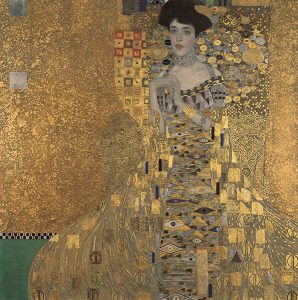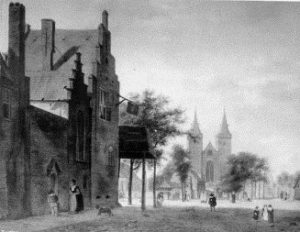Throughout WII, one of Nazi’s Germany’s campaigns was to loot art from Jews all over Europe. Despite post-war efforts by the allies to recover and return a wide range and quantity of this art, much did not make it back to their original owners or were never relocated. In fact, some private holdings of art by Nazi Germans remained in their possession or were given back to them after the war. Some famous cases have been brought to the forefront of public attention, most notably the five Gustav Klimt paintings and the lawsuit against the Austrian government for their return, as dramatized in the film The Woman in Gold. In this case, the niece of Adele Bloch-Bauer, who was often a subject and patron of his paintings, sued the Austrian government for their return. The paintings were seized by the Nazis from the Bloch-Bauer family townhouse in Vienna during World War II. The entire family home and collection was raided… the Klimt paintings originally hung in Adele’s private apartment. Her niece, Maria Altmann and the suit lawyer Randol Schoenberg won the case, and Altmann later gifted them to the Neue Gallerie in New York where they remain.

Another painting by a famous artists had a similar journey from Jewish to Nazi hands, but was never returned. View of a Dutch Square by the Dutch artist Jan van der Heyden– a painter from the Dutch golden age– was part of a personal collection owned by Gottlieb and Mathilde Kraus, whose home in Vienna was raided by the Nazi police. Hitler’s private secretary, Henriette von Schirach, requested “nearly 3,000 works” including View of Dutch Square form the Bavarian government. These were given to her at a heavily discounted price (aprox. $600) and was apparently a common practice. These “return sales” were secret sales that have begun to be uncovered as people search into the provenience of museum holdings and lost art.

Yet again, a famous case involving nazi looted art became a major motion picture. The film Monuments Men tells the story of a volunteer force dubbed Monuments Men, whose mission was to protect churches, museums and cultural artifacts from damage in Allied attacks. Soon they began to focus on recovering artifacts looted by Nazi Germany, and found masterpieces in some impressive hiding spots, including tunnels inside the Altaussee Salt Mine in Austria. In it they found over 6,000 paintings including masterworks such as Michelangelo’s Madonna of Bruges and the Ghent Altarpiece. Given the scope of stolen and misplaced art during Nazi’s extensive and vigorous plundering, this effort became the Monuments Men Foundation which continue its efforts today.
Modern efforts continue in attempt to remedy some of the damage caused by Nazi looting of Jewish holdings throughout Europe. The Lost Art Database “registers cultural objects which as a result of persecution under the Nazi dictatorship and the Second World War were relocated, moved or seized, especially from Jewish owners” as part of the German Lost Art Foundation, a government initiative. The work of organizations and conferences to regain the cultural patrimony wrongfully taken by Nazi Germany remains vital.
Works Cited:
http://www.jewishvirtuallibrary.org/recovering-stolen-art-from-the-holocaust
http://www.neuegalerie.org/content/gustav-klimt-and-adele-bloch-bauer-woman-gold
https://www.nytimes.com/2016/07/16/arts/design/nazi-art-loot-returned-to-nazis
http://www.lostart.de/Webs/EN/LostArt/Index.html
http://www.history.com/news/the-real-life-story-behind-the-monuments-men
Additional Reading:
http://www.lootedart.com/
https://www.archives.gov/research/holocaust/records-and-research/documenting-nazi-plunder-of-european-art.html (can also search their archives)



